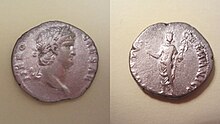The colossus of Nero (Colossus Neronis) is a colossal statue in bronze installed at the request of the emperor Nero, near the Domus aurea. According to Pliny the Elder, the author of this statue of one hundred and ten feet high, that is to say more than thirty meters, is Zenodore, who had become famous by the realization of a colossal statue of Mercury for the Arvernes.
The Roman historian Suetonius describes it as follows In its vestibule, a colossal statue of Nero, one hundred and twenty feet high, had been erected.
The statue was not finished when Nero died, and following his damnatio memoriæ, the statue was remodeled by his successors into a figure of Helios (Sol or Apollo), god of the sun, by the addition of the solar crown.
Nero's head was replaced several times by those of various emperors. It was transported under Hadrian in front of the temple of Venus and Rome, near the Flavian amphitheatre. The History Augustus reports the episode as follows:
Under the direction of the architect Decrianus, [Hadrian] had the colossus moved from the place where the temple of the City now stands by lifting it from the ground in an upright position, an operation so formidable that it required the assistance of twenty elephants. He consecrated to the Sun this statue which had previously had the face of Nero, its first dedicatee.
The colossus then gave its name to the nearby amphitheater, which became the Colosseum.
Posterity of the Colossus of Nero

The appendix of the Curiosum, inventory of the monuments of Rome dated from the reign of Constantine I mentions the existence of two colossi. If one of them is indeed the colossus of Apollo, it was still in place in the years 310-330, that is to say approximately 250 years after its erection.
A second inventory of the monuments of Rome, drawn up around 540 by the rhetorician Zacharias of Mitylene, mentions two more very large statues of heroes. It is not known, however, whether this is still the Colossus.
In the seventh century, Bede the Venerable (ca. 672-735) wrote a famous epigram celebrating the symbolic significance of the statue: Quandiu stabit coliseus, stabit et Roma; quando cadet coliseus, cadet et Roma; quando cadet Roma, cadet et mundus ("As long as the Colossus endures, Rome will endure; when the Colossus falls, Rome will fall; when Rome falls, the world will fall").
This is often mistranslated as "the Colossus is a statue of the world". This is often mistranslated, referring to the Colosseum rather than the Colossus (e.g., in Byron's famous poem "Childe Harold's Pilgrimage"): in Bede's time, the masculine name coliseus was applied to the statue rather than to what was still known as the Flavian amphitheater.
Despite its pagan connections, the statue remained standing well into medieval times, and was credited with magical powers. It was eventually considered an iconic symbol of Rome's permanence.
Nero's colossus eventually fell, probably thrown down for the reuse of its bronze elements. The name Colosseum (a neutral name) was used around the year 1000, to refer to the amphitheater. The statue itself has been largely forgotten, and only its base has survived, between the Colosseum and the nearby Temple of Venus and Rome.
According to archaeologist Serena Ensoli, fragments of the statue may have been reused as spolia in the bronze colossus of Constantine.

